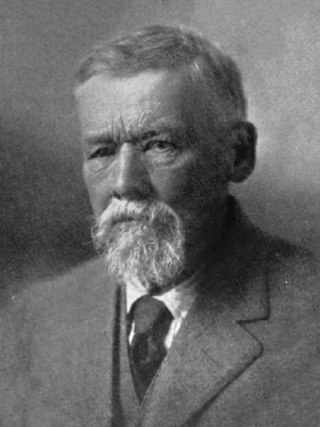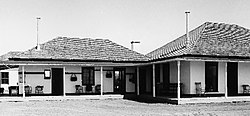Cora Viola Howell, later to become Viola Slaughter, was an Arizona rancher and the wife of Sheriff John Horton Slaughter, known as Texas John Slaughter.

Apache May Slaughter was the adopted daughter of Tombstone, Arizona sheriff John Slaughter and his wife Viola.

John Horton Slaughter, also known as Texas John Slaughter, was an American lawman, cowboy, poker player and rancher in the Southwestern United States during the late 19th and early 20th centuries. After serving in the Confederate States Army during the American Civil War, Slaughter earned a reputation fighting hostile Indians and Mexican and American outlaws in the Arizona and New Mexico territories. In the latter half of his life, he lived at the San Bernardino Ranch, which is today a well-preserved National Historic Landmark in Cochise County in far southeastern Arizona. In 1964, he was inducted into the Hall of Great Westerners of the National Cowboy & Western Heritage Museum.
Malpai Borderlands is a region, or areal feature, along the U.S.-Mexico border at the Arizona and New Mexico state line. It encompasses the extreme southeast corner of Arizona and the southwest corner of New Mexico describe the general vicinity. It includes areas inside the U.S. states of Arizona and New Mexico as well as the Mexican states of Chihuahua and Sonora.

The beautiful shiner is a species of ray-finned fish in the family Cyprinidae. It is found in Mexico and Arizona and New Mexico in the United States. It is one of 22 species of Cyprinella found in North America.

The Yaqui chub is a species of freshwater fish in the family Cyprinidae. It is found in northern Mexico and the United States. The Yaqui chub is a medium-sized minnow fish that historically occurred in streams of Rios Matape, Sonora, and the Yaqui systems of Sonora, Mexico. It is one of the five species of the genus Gila in Arizona. The Yaqui chub is closely related to G. ditaenia, and G. orcutti ; and shares several physical characteristics with the G. orcutti, but proves different by having a black wedge near the base of the caudal fin.

Ictalurus pricei, the Yaqui catfish, is a species of North American freshwater catfish native to Mexico and Arizona.
The San Bernardino springsnail is an endangered species of freshwater snail in the family Hydrobiidae. This species is endemic to a small number of springs in the USA and northern Mexico.
Hereford is a populated place in Cochise County along the San Pedro Riparian National Conservation Area in the southern part of the U.S. state of Arizona. It is southeast of Sierra Vista and is a part of the Sierra Vista-Douglas micropolitan area. The elevation is 4,193 feet at the location of the original townsite at the far eastern end of the unincorporated area; the residential area runs for another 8 miles west from this location, blending into the unincorporated area of Nicksville at an elevation of approximately 4800'. Hereford Station Post Office is located at the far western end of Nicksville, at the foot of the Huachuca Mountains.
The Rio Bavispe or Bavispe River is a river in Mexico which flows briefly north then mainly south by southwest until it joins with the Aros River to become the Yaqui River, eventually joining the Gulf of California.

Leslie Canyon National Wildlife Refuge is a National Wildlife Refuge of the United States located in Arizona. The 2,770-acre (11.2 km2) refuge was established in 1988 to protect habitat for the endangered Yaqui Chub and Yaqui Topminnow. The refuge also protects a rare velvet ash-cottonwood-black walnut gallery forest.

The San Bernardino National Wildlife Refuge is located on the U.S.-Mexico border in Cochise County, Arizona. Situated at 3,720 to 3,920 feet (1,130–1,190 m) elevation in the bottom of a wide valley, the refuge encompasses a portion of the headwaters of the Yaqui River, which drains primarily western Chihuahua and eastern Sonora, Mexico. The 2,309-acre (9.34 km2) ranch was acquired by the U.S. Fish and Wildlife Service in 1982 to protect the water resources and provide habitat for endangered native fishes.
The Yaqui longfin dace is a small fish of the American Southwest and northern Mexico, and considered a form of the longfin dace. It is often referred to as Agosia chrysogaster sp 1.

The San Bernardino Valley of Arizona is a 35 mi (56 km) northeast-by-southwest trending valley in extreme southeast Cochise County, Arizona. The north end of the valley merges into the northwest-by-southeast trending San Simon Valley; both merge in western perimeter Hidaldgo County, New Mexico. The valley is an asymmetric graben.

Presidio San Agustín del Tucsón was a presidio located within Tucson, Arizona, United States. The original fortress was built by Spanish soldiers during the 18th century and was the founding structure of what became the city of Tucson. After the American arrival in 1846, the original walls were dismantled, with the last section torn down in 1918. A reconstruction of the northeast corner of the fort was completed in 2007 following an archaeological excavation that located the fort's northeast tower.

The San Rafael Ranch, formerly known as the Greene Ranch, is a historic cattle ranch located in the San Rafael Valley about a mile and a half north of Lochiel, Arizona, near the international border with Sonora, Mexico.

The Little Boquillas Ranch is an historic ranch property located in western Cochise County, Arizona, near the Fairbank Historic Townsite in what is now part of the San Pedro Riparian National Conservation Area.
Lucía Martínez (Woolsey) (1854–1900) was a woman of Yaqui descent who was the first Indigenous women to file a legal challenge against an Arizona statesman. It is assumed she was born in Sonora in 1854 and was taken into the Apache slave trade at a young age. Martínez escaped in 1864 at the age of 10 but was quickly captured again, this time by “King” Samuel Woolsey. She became Woolsey’s indentured servant under the Howell Code and was also a sexual servant to Woolsey. Martínez gave birth to 3 of Woolsey’s biological children and following his marriage to Mary H. Taylor in 1871, lost custody of her two eldest daughters. Lucía found herself a lawyer with the intention of regaining custody and that same year filed a Habeas Corpus petition. Her case made it to court and the outcome was not what she had hoped, “King” Woolsey maintained custody with Martínez receiving only temporary custody. After Woolsey’s death in 1879, Martínez was granted custody again and took further legal action in an attempt to receive an inheritance for her children. Although she did not succeed, she still received $1,000 from an indenture bond that had been signed in court 8 years prior.














